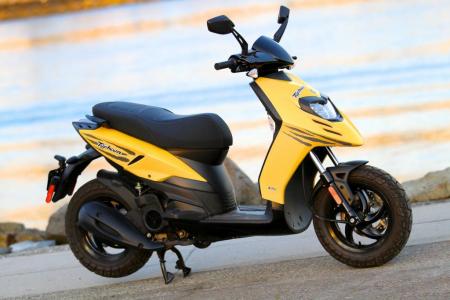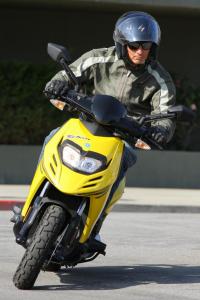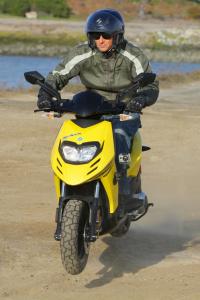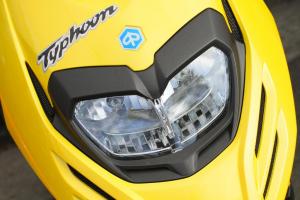 The latest trend among car manufacturers is reaching the coveted 40 mpg mark. It’s a nice, round number far exceeding what sedans — even the most miserly ones — were capable of only a few years ago. And with gas prices not getting any cheaper, it’s easy to see why fuel efficiency is so important. Of course, we motorcyclists have been touting the virtues of two-wheel fuel economy forever, and thePiaggio Typhoon 125 is the latest example why.
The latest trend among car manufacturers is reaching the coveted 40 mpg mark. It’s a nice, round number far exceeding what sedans — even the most miserly ones — were capable of only a few years ago. And with gas prices not getting any cheaper, it’s easy to see why fuel efficiency is so important. Of course, we motorcyclists have been touting the virtues of two-wheel fuel economy forever, and thePiaggio Typhoon 125 is the latest example why.
Piaggio claims the Typhoon can achieve an astonishing 90 mpg from its tiny 124cc single-cylinder, four-stroke engine. This assumes its rider is delicate with the controls and avoids continued high speeds in order to achieve maximum fuel economy. In our real-world testing, which involved twisting the throttle to the stop quite frequently to rid ourselves of four-wheel, intercity traffic, that number dropped considerably to 52 mpg. However, that’s still an impressive number considering how hard we thrashed the scoot – it would be nearly impossible to get worse mileage
Another notable figure is its price. At just $2699, the Typhoon is a natural choice for anyone looking for cheap, reliable transportation, and puts it well below competitors like the Honda PCX ($3399) andYamaha Zuma 125 ($3350). We’ll have a comparison of all three scooters soon.
From Italy, With Love
For those unfamiliar, the Italian brand Piaggio specializes in scooters. While the MP3 line of three-wheel scooters that lean like a conventional motorcycle may be their best-known model in the U.S., the company also produces more traditional models. Parent company, the Piaggio Group, also owns a variety of brands to draw knowledge from, including Vespa,Aprilia, Gilera and Moto Guzzi, to name a few.
In the case of the Typhoon 125, the steel trellis frame incorporates a step-through design simplifying ingress and egress. Despite the Typhoon’s malevolent name, it’s actually powered by a modest 124cc single-cylinder engine that Piaggio says churns out a (insert smirk) stump-pulling 6.0 ft.-lbs. of torque and 9.6 hp. It’s mated to a continuously variable transmission (CVT) for true “twist-n-go” usability.
I’ll admit some apprehension when first riding the Typhoon as I wasn’t sure if I would be a moving roadblock among the sea ofcars. Those fears were quickly overcome as the scoot had adequate power to blend among the traffic. It even has enough pull to holeshot stoplight-to-stoplight drag races against unsuspecting cage drivers, though the Typhoon does bog slightly leaving a stop; an indication of lean fueling. Piaggio claims a top speed of 60 mph, but its speedometer registered as high as 70 mph on level ground and can go faster with the help of a steep decline. It should be noted, however, that because its engine is under 150cc, the Typhoon is not legal for freeway use.
All the better, too, as the stability from the 120/80-12 front and 130/80-12 rear knobby-ish tires gets a little skittish at higher speeds. Suspension consists of a conventional, non-adjustable telescopic fork in front and a single rear shock, adjustable for spring preload. Considering the Typhoon is meant to live on bumpy city streets, damping is a touch on the soft side, though not excessively so, providing a fairly comfortable scootering experience.
A Different Kind of Riding Experience
Having lately ridden sportbikes almost exclusively, hopping aboard the Typhoon couldn’t be any more different. Its comfortable, wedge-like seat sits 30 inches from the ground, meaning my 30-inch inseam could only manage placing the balls of my feet on the tarmac. Its light weight makes it feel like a toy, which equates to easy maneuvering through traffic. The downside to this small stature is fidgety handling when faced with strong crosswinds or poorly maintained roads, as more effort is required to maintain a line, even going straight.
Passenger accommodations haven’t been forgotten, as the Typhoon features a well padded pillion seat with grab rails and floorboards instead of footpegs. The grab rails also double as a handle to help place the scoot on the centerstand when parked. While it’s easy enough to lever onto the centerstand, not including a side stand is a minor inconvenience.
Storage area is confined to the single compartment under the saddle, large enough to accommodate a three-quarter helmet though not much else. A hook just underneath the bars is great for affixing grocery bags, but its fairing lacks convenient things like a water bottle holder or any sort of storage cubbyholes.
Those aren’t our only gripes. The carbureted engine can be a bit temperamental during cold starts, sometimes requiring more than one attempt at the button before coming to life. This, too, is another indicator that the Typhoon runs lean. Once on, the automatic choke will activate and raise engine speed while it reaches optimum operating temperature. We noticed on a few occasions the engine would stall when applying a heavy dose of throttle while still cold.
The Cure For Road Rage
If you’re like us, numerous everyday errands are near your home. Jumping in the car or suiting up for your sport-tourer just to run to the bank seems like overkill. The Piaggio Typhoon 125 is a sensible, affordable alternative. More than just cheap, reliable transportation, the Typhoon is also a gateway scooter into the world of larger two-wheelers.
Yes, more storage compartments would be nice, but at just $2699, one’s willing to make a few concessions. It’s also available in black in case the yellow version seen here is not your style.
Related Reading
2012 Yamaha Zuma 50F Review
2012 Kymco Scooter Lineup Review
2011 Honda PCX Review
2010 Honda Elite Review
2008 Piaggio MP3 500 i.e. Review
2008 Piaggio MP3 400 Review
 4:32 AM
4:32 AM
 Chiken Joe
Chiken Joe







 Posted in:
Posted in: 







0 comments:
Post a Comment